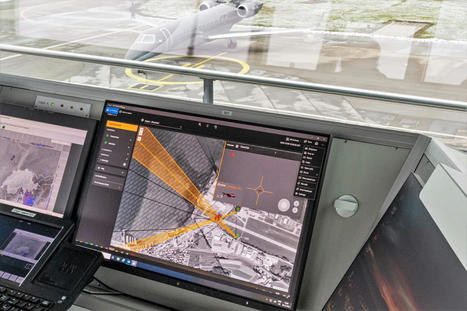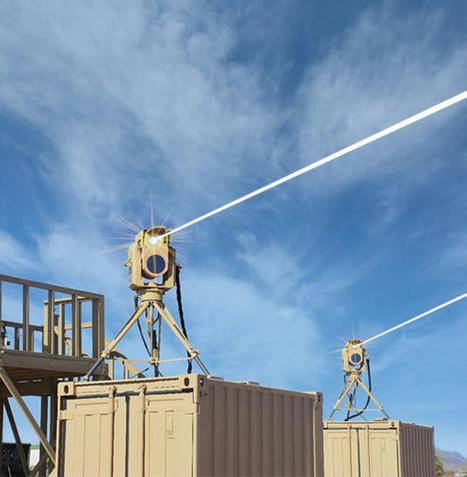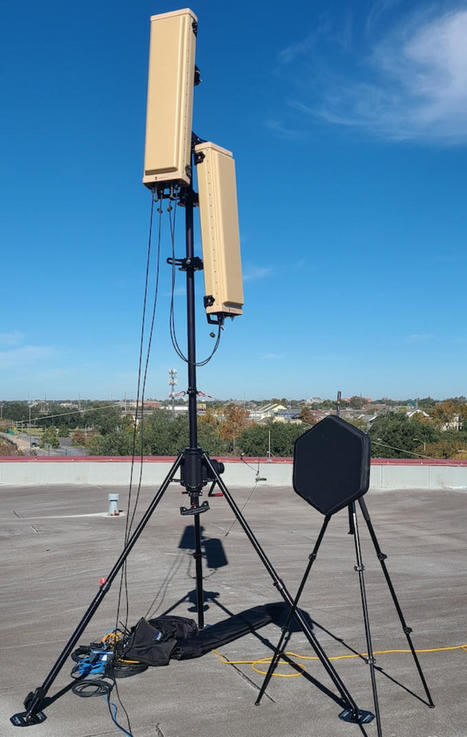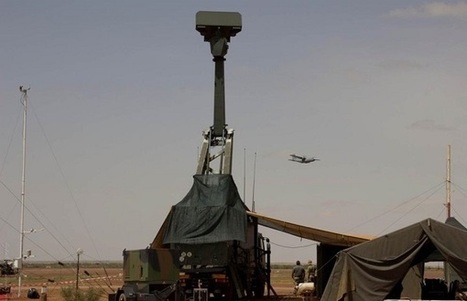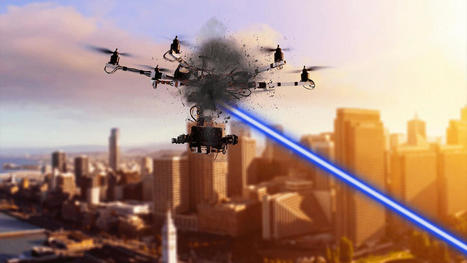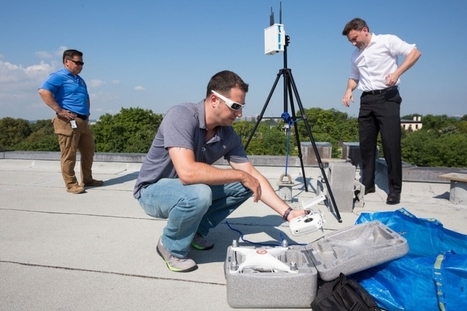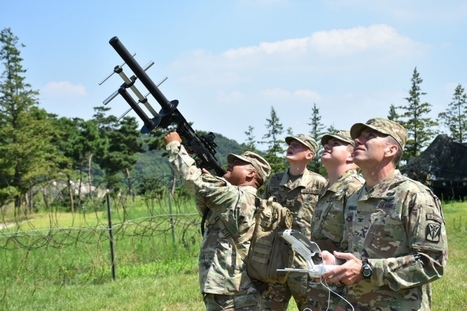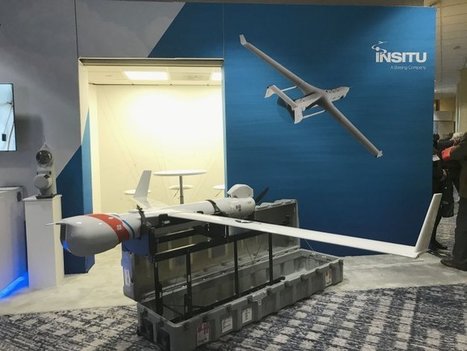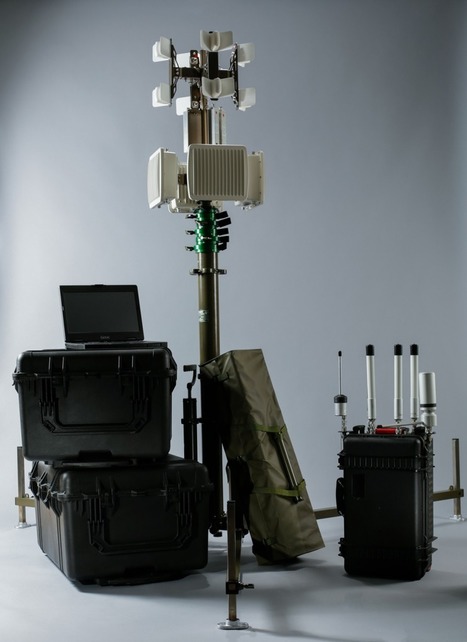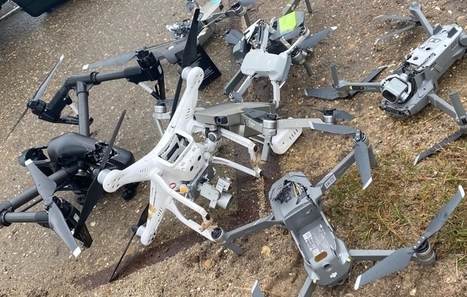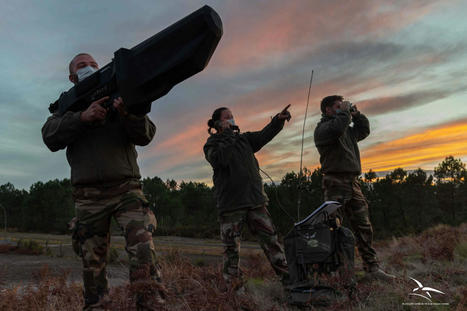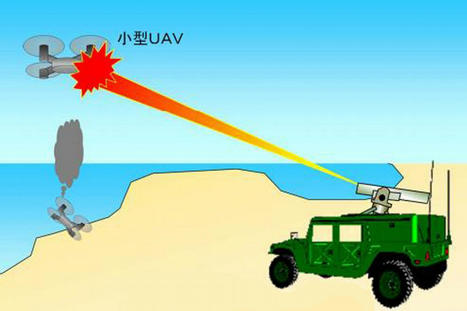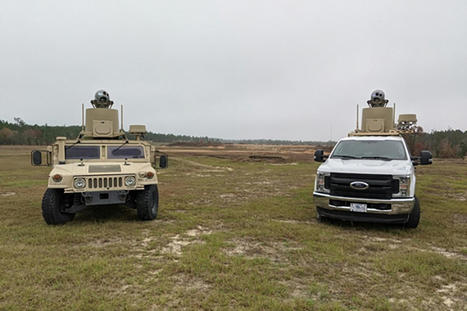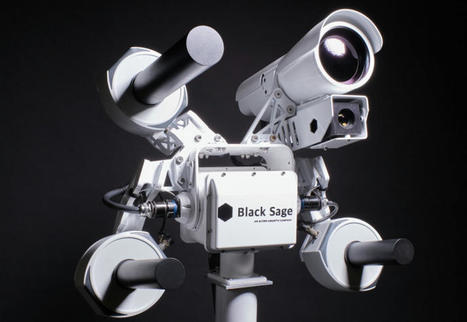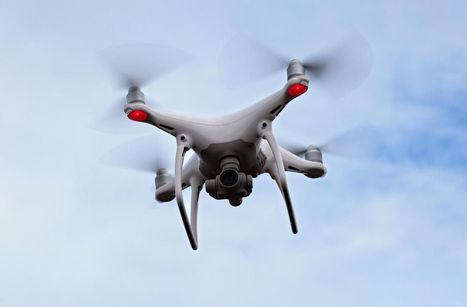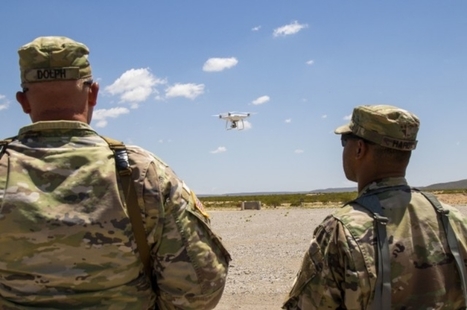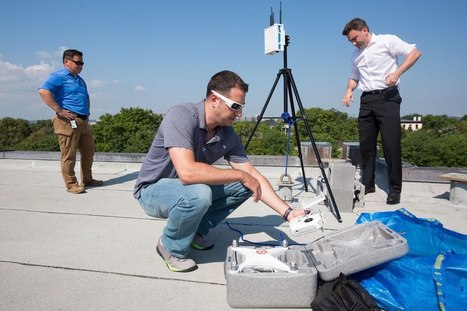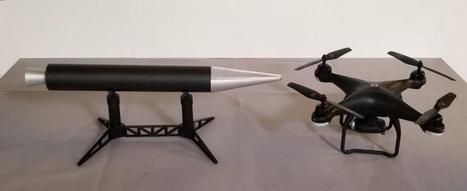 Your new post is loading...
 Your new post is loading...

|
Scooped by
Romain
December 18, 2020 4:08 AM
|
DroneShield Ltd (ASX:DRO) (“DroneShield” or the “Company”) is pleased to announce deployment of its multi-sensor C-UAS DroneSentry™ system at the Altenrhein Airport in Switzerland, as well as provide an update on record Purchase Orders and customer cash receipts for the quarter to date.
Altenrhein Airport deployment
The deployment consists of the following DroneShield solutions:
multiple RfOne™ units, able to detect, ID and track single or swarms of UAS in real time, at the world leading 8km range, as well as indicate the location of the UAS pilot
DroneOpt™ optical verification systems, with DroneShield proprietary DroneOptID™ AI-based engine, with ability to ID and track the UAS and its payload
DroneSentry-C2™ command-and-control (“C2”) user interface, an intuitive, low cognitive burden C2 with ability to alert and track the incoming UAS in real time, as well as provide extensive reporting functionality, creating a high degree of UAS flight awareness around the airport precinct.
The system is entirely passive (no emissions) with no interference to other equipment, making it well suited for the airport environment.
Oleg Vornik, DroneShield’s CEO, has commented,
“Airports have experienced a substantial degree of disruption due to UAS flights at their facilities. Small UAS present multiple well-documented dangers to the airliners, including critical engine damage risk in the event the UAS and its lithium batteries, come into contact with it, or creating windshield cracks on impact.”
Timo Nielsen, the Altenrhein Airport Safety & Compliance Manager, has commented,
“We are pleased to partner with DroneShield, as the global leader in the C-UAS space, for the deployment at our airport, enabling us to receive actionable awareness of the UAS activity in our air space. Importantly, as a forward-leaning airport, we welcome visits from other airports in Europe and elsewhere globally, to contact us or DroneShield, to learn more about the deployed system, and see it at a working airport facility.”
Learn more about counter drone airports and how DroneShield serves airports, visit:
www.droneshield.com/airports

|
Scooped by
Romain
December 16, 2020 12:42 AM
|
Boeing a annoncé avoir remis au Department of Defense des systèmes laser modernisés.
Systèmes d'armes laser compact.
Boeing a annoncé le 9 décembre avoir livré au DoD (Department of Defense) un premier lot de lasers modernisés, qui viendront compléter les moyens de lutte anti-drones de l'armée américaine. L'industriel américain a ainsi été chargé de moderniser les systèmes CLWS (Compact Laser Weapon System) afin d'accroître le niveau de puissance des faisceaux laser, bien que les nouvelles performances n'aient pas été détaillées. Un second lot de CLWS modernisés devrait être remis au DoD au cours du premier trimestre 2021.
Lutte anti-drones.
Ces systèmes, auxquels les forces américaines ont de plus en plus recours, « fourniront aux combattants une protection améliorée contre les systèmes de drones, plus nombreux et plus hostiles », rapporte ainsi Boeing. Le système modernisé devrait également permettre d'engager la cible plus rapidement et offre, toujours selon l'industriel, de très bons résultats. Ainsi, lors d'essais menés en Arizona, le DoD est parvenu à neutraliser l'ensemble des objectifs (soit 12 drones) à l'aide du CLWS. Par ailleurs, en septembre dernier, des essais ont été menés dans un contexte de protection de convois. Le CLWS était alors intégré à bord d'un petit véhicule tactique.
US Air Force.
Si Boeing n'a pas précisé qui serait l'utilisateur final du CLWS, Raytheon continue de son côté à travailler avec l'US Air Force. En septembre dernier, l'industriel a ainsi livré à l'USAF un nouveau système laser, nommé HELWS (high energy laser weapon system), devant être déployé dans un cadre opérationnel, en dehors du territoire américain, à des fins d'évaluation. A partir des RETEX des militaires, Raytheon a également procédé à une modernisation de son système afin de renforcer sa robustesse et sa précision. Existant en versions fixe et mobile – il peut être intégré sur un véhicule type buggy Polaris MRZR – le système HELWS permettrait de neutraliser une douzaine de drones en un seul coup, détaille Annabel Flores, vice présidente de l'activité systèmes de guerre électronique de Raytheon. Il est ainsi couplé à un capteur électro-optique et à un radar Ku720, permettant de détecter et suivre les cibles d'intérêts. Le HELWS, désormais certifié, sera principalement employé pour la défense aérienne des bases de l'USAF.

|
Scooped by
Romain
December 10, 2020 12:46 AM
|
DroneShield Ltd and Squarehead, a Norwegian-based acoustic array technology company, have entered into a partnership in the C-UAS space.
Going forward, DroneShield will be offering an integrated system for C-UAS detection and mitigation, with DroneShield’s radiofrequency, radar and camera-based UAS detection and electronic warfare UAS defeat products integrated with Squarehead’s Discovair G2 direction-finding acoustic system, within DroneSentry-C2 airspace awareness, command-and-control and reporting software. This product integration of the two companies’ offerings has been completed, and the combined solution is available to customers at present. The combined system is presently undergoing test evaluation schedule with the U.S. Department of Defense.
Squarehead CEO Stig Nyvold said:
“We are pleased to enter into the partnership with DroneShield in the rapidly emerging C-UAS space. C-UAS security and airspace awareness is becoming an increasing problem for wide range of military and civilian customers, and we expect our capability to detect any drone in the near field to provide a great added layer in DroneShield’s solution.”
DroneShield’s DroneSentry multi-sensor C-UAS system with integrated Squarehead Discovair G2 acoustic direction finding sensors
Oleg Vornik, DroneShield’s CEO, added:
“This partnership combines DroneShield best-in-class C-UAS sensors and effectors with Squarehead’s expertise in the acoustic domain. The combined system is already being evaluated by the US military, and we look forward to rolling this out globally, with an extensive schedule in front of us over next several months, including Europe and the US. ”
Source: Press Release
Posted in Anti-Drone, Business News, News and tagged Author, CUAS on December 9, 2020 by The Editor. Leave a comment

|
Rescooped by
Romain
from DEFENSE NEWS
December 2, 2020 5:50 AM
|
En janvier, lors de ses voeux aux Armées, le président Macron avait brièvement parlé du déploiement en Arabie Saoudite de la « Task Force Jaguar », dont il n’avait été jamais explicitement question jusqu’alors. Aucun communiqué n’avait en effet annoncé le lancement de cette mission. Et les points de situation publiés chaque semaine par l’État-major des armées [EMA] n’en firent la moindre mention.
Cependant, cette mission avait pourtant bien été évoquée quelques semaines plus tôt, à l’occasion d’un discours prononcé en anglais par Florence Parly, la ministre des Armées, lors d’un déplacement à Bahreïn. « Plus tôt, dans ce mois, après les attaques contre Abqaiq et Kurais [deux sites pétrolier saoudiens visés par des missiles et des drones le 14 septembre 2019, ndlr], j’ai envoyé de robustes moyens d’alerte avancée, dont un radar sophistiqué et des dizaines de servants, afin de dissuader les attaques de drones et de missiles de croisière », avait-elle dit, après avoir fait une allusion à l’accord de défense qui lie la France aux Émirats arabes unis.
Peu après les voeux du président, un dépêche de l’agence Reuters précisa que la France avait envoyé un radar Giraffe AMB sur la « côte Est de l’Arabie Saoudite », soit dans la zone où les sites pétroliers avaient été attaqués.
Depuis, la ministre a parlé cette mission qu’à une seule reprise [sauf erreur], lors d’une audition au Sénat. « Dans le Golfe, l’épidémie a affecté certaines relèves, repoussées en raison de la fermeture de frontières, notamment pour la task force Jaguar en Arabie Saoudite, créée à la suite de l’attaque de septembre 2019 », a-t-elle dit.
Et le sujet n’a plus été abordé par la suite. Y compris [si l’on en juge par le compte-rendu] lors de l’audition de Mme Parly sur les exportations d’armement, à l’Assemblée nationale. Toujours très allant quand il s’agit de parler des ventes d’armes à l’Arabie Saoudite, le député Alexis Corbière n’a visiblement pas pensé interroger la ministre sur cette Task Force Jaguar.
Cela étant, une telle discrétion est aussi de rigueur de l’autre côté de la Manche. Ce qui peut éventuellement se comprendre étant donné qu’une décision de justice avait conduit le gouvernement britannique à suspendre les ventes d’armes à l’Arabie Saoudite, le temps que son appel soit examiné. En juin, le Premier ministre, Boris Johnson, a décidé de reprendre les livraisons.
En effet, il aura en effet fallu attendre la publication d’un rapport annuel du ministère britannique de la Défense [MoD] pour apprendre qu’une mission militaire avait été envoyée à Riyad pour mettre en oeuvre un radar Giraffe, à partir de février 2020. Et cela, sans l’annoncer aux parlementaires. Ce qui fait quelques remous…
« Des troupes britanniques ont été envoyées pour défendre des gisements de pétrole en Arabie saoudite à l’insu du parlement et du public », a ainsi affirmé le quotidien The Independent, le 27 novembre.
« Les informations selon lesquelles le gouvernement aurait secrètement déployé des troupes en Arabie saoudite sont choquantes », a fustigé Layla Moran, porte-parole des libéraux démocrates pour les Affaires étrangères. « Le gouvernement s’est dérobé à sa responsabilité de tenir le parlement et le public informés de l’opération », a estimé Stephen Morgan, qui s’occupe des questions militaires au Parti travailliste. « Le Parlement doit être tenu informé des opérations non secrètes telles que celles-ci afin de garantir un contrôle parlementaire adéquat et la transparence », a-t-il ajouté.
Cela étant, le MoD a donné quelques précisions. Ainsi, les militaires de la British Army envoyés en Arabie Saoudite sont issus du 16th Regiment Royal Artillery. Et le coût de ce déploiement serait de 840.360 livres sterling.
Photo : Radar Giraffe / EMA

|
Scooped by
Romain
November 26, 2020 4:54 PM
|
Cilas, filiale de d'Ariane, a créé une arme laser capable de détruire drones et mini drone à un kilomètre de distance. Elle pourra à terme neutraliser roquettes, tirs d'artillerie et obus de mortier.
La guerre des drones se poursuit avec une arme redoutable destinée à les détruire. Il s'agit d'Helma-P, un canon laser créé par Cilas, une filiale d'Arianegroup. Lors d'un premier essai, qui s'est déroulé sur le site des Landes de la Direction générale de l’armement (DGA) à Biscarosse, cette arme a prouvé son efficacité. Elle a neutralisé plusieurs drones en quelques secondes après les avoir détectés volant à une distance d'un kilomètre.
Tous les tirs ont permis de détruire systématiquement les drones pouvant évoluer à des vitesses supérieures à 50 km/h et dans des conditions de poursuite de cibles difficiles", explique Cilas dans un communiqué précisant que cet effecteur peut atteindre des drones et des mini-drones.
En plus d'être précis et rapide, Helma-P offre l'avantage d'être léger mobile et donc de pouvoir être transporté sur le terrain et installé sur un véhicule dans un convoi. Une version fixe a aussi été mise au point pour la surveillance de sites sensibles civils ou militaires.
a mission sera de sécuriser les opérations sur le territoire national lors d’événements et de soutenir les opérations extérieures en identifiant, poursuivant et neutralisant la menace fixe ou agile", indique Cilas.
Roquettes et tirs de mortier
On note, depuis quelques années, l’avènement de la menace drone pour du renseignement ou de l’attaque par explosifs. Cette menace demeure une problématique complexe à traiter, du fait de la diversité et de la prolifération des drones à bas coûts et de leur autonomie croissante qui les immunise contre le brouillage", explique le ministère des Armées.
Si pour le moment, Cilas est une arme anti-drone, son champ d'action a vocation à s'élargir pour détruire des "dispositifs explosifs improvisés en neutralisant les explosifs ou détruisant l’électronique". A terme, il pourra aussi faire face à des tirs de roquettes, d'artillerie ou de mortier.
https://twitter.com/PascalSamama
Pascal Samama

|
Scooped by
Romain
November 24, 2020 12:19 AM
|
High-power microwave system is tested with integrated radar and C2 software
US-based Black Sage has extended its C-UAS collaboration with the DoD after providing a radar system and specialist software for integration with an electromagnetic weapon.
The radar provides precise targeting data for the Air Force Research Laboratory's (AFRL’s) Tactical High Power Microwave Operational Responder (THOR) system.
Open architecture ...

|
Scooped by
Romain
November 13, 2020 6:39 AM
|
Citadel Defense has pushed a new AI and machine learning software release to Titan systems deployed across thirteen countries. The software has evolved over 27 months of successful deployments across multiple combatant commands and hundreds of unique environments.
Owning the world’s largest dataset adapted for AI-based drone detection, Citadel can quickly and cost-effectively extend protection against emerging foreign-built drones, like those used in recent attacks on Armenia and the Middle East, that evade legacy counter drone systems.
As the Pentagon looks for reliable ways to counter commercial quadcopter attacks on American troops in Iraq, Afghanistan, and Syria, Citadel’s proven AI capabilities provide the necessary protection and responsiveness for the evolving C-sUAS mission.
“Library-limited counter drone systems that are overly complex put important missions at risk along with our servicemen and women. Titan’s use of AI, machine learning, and automated robotics significantly reduces operator stress while accelerating response time,”
explains Christopher Williams, CEO of Citadel Defense.
The leader of U.S. Central Command, General McKenzie, expressed concern that the growing threat posed by unmanned aircraft systems, coupled with the lack of dependable capabilities to counter them, was the most concerning tactical development in the CENTCOM region.
“By substantially reducing system complexity, providing an industry-leading low false alarm rate, and delivering the most expansive detection and mitigation threat coverage, Citadel’s customers can focus on their missions without unnecessary and potentially life-threatening distractions,” says Williams.
Citadel’s radiofrequency sensors bring the most advanced AI and machine learning detection performance to integrated layered counter drone solutions. The system’s open architecture allows for quick integration with other sensors, offering a suite of options that match any mission need or configuration.
Citadel aims to make C-sUAS protection ubiquitous across government, military, and commercial force protection missions. With $30M in Government contracts for their Titan solution, the company recently tripled manufacturing production capacity to deliver on urgent contracts.
Source: Press Release

|
Scooped by
Romain
November 12, 2020 5:58 AM
|
Beginning early next year, the Pentagon will host the first opportunity for industry to demonstrate counter-drone technology aimed at small systems, the next step in a plan to test out new capabilities twice a year at common test ranges, according to Army officials in charge of the effort.
Pentagon leaders approved in late September a set of requirements to help counter small drones, laying a path for how industry can develop technology to plug into a single command-and-control system.
The Joint Counter-Small Unmanned Aircraft Systems Office, or JCO, kicked off the pursuit with an industry open house Oct. 30.
The defense secretary delegated the Army in November 2019 to lead the effort to consolidate the wide range of counter-small unmanned aerial system, or C-sUAS, capabilities into a select group of interim systems. Those systems have now been chosen, with the JCO turning its sights toward establishing an enduring collection of capabilities — while acknowledging that there’s no silver bullet and that a layered approach is needed, using both kinetic and non-kinetic means, to defeat small drones.
The JCO has identified three sites for common test ranges to conduct evaluation and testing of promising counter-drone technology, according to Col. Greg Soule, resources director for the Army’s Rapid Capabilities and Critical Technologies Office. The RCCTO is supporting the JCO by helping identify material solutions for C-sUAS, and it is leveraging its work on directed-energy and high-power microwave technologies to roll into a solution.
A decision memo on locations is awaiting approval by Army Vice Chief Gen. Joseph Martin. Soule said those locations will be shared “when the time is right.”
The JCO also set up a working group to look into testing C-sUAS capabilities in an urban environment, according to Soule.
To ensure the JCO is comparing apples to apples when it comes to counter-drone technology, it also stood up a working group with representatives across all the armed services to establish joint test protocols. That protocol is out for signature and should be in hand by Nov. 6.
Additionally, Ellen Lord, the undersecretary of defense for acquisition and sustainment, has asked the JCO to look at the feasibility of establishing a single source for training targets “to help reduce costs, reduce lead times and streamline the waiver process,” Soule said. “All services already have sources for where they go now. So potentially we could find a way to find some synergies and efficiencies.”
Industry interest
Industry is eager to get technology in front of both the JCO and RCCTO. Many defense companies participating in the Association of the U.S. Army’s annual virtual conference last month highlighted counter-drone capability.
General Dynamics Mission Systems featured its recent partnership with Dedrone, a leader in drone detection and defeat technologies using machine-learning software, sensors and electronic attack methods.
Lockheed Martin showcased its MoRFIUS C-sUAS capability that it is working on with the RCCTO. MoRFIUS uses high-power microwave technology in an aerial platform. That capability can be used to extend the range beyond current counter-drone defeat systems to defeat drone swarms. MoRFIUS is a recoverable and reusable technology.
Leonardo DRS also highlighted its mobile counter-drone capability using Moog’s Reconfigurable Integrated-weapons Platform turret with multiple kinetic effectors, different electro-magnetic and infrared sensors, an onboard radar, and electronic warfare technologies.
Raytheon, which has a foothold in the C-sUAS market with its Coyote Block II kinetic effector and its Ku-Band Radio Frequency System, emphasized its track record and upgrades to the system.
The industry open house had roughly 500 industry representatives tune in. The JCO will select industry applicants to show off their capabilities at the first demo, which is to take place in the second quarter of fiscal 2021.
At the demonstration, the JCO will provide instrumentation and threat surrogates as well command-and-control elements. Industry participants will need to bring technology to defeat drones, said Adam Martin, who briefed industry on test ranges and protocols at the open house.
There will be technology insertion points in the enduring architecture after each demonstration that address gaps, he added.
Photo:A Dedrone RF-100 drone-detection sensor on the roof of Fort Lesley J. McNair’s Marshall Hall. (Photo courtesy U.S. Army)
Source: Defense News

|
Scooped by
Romain
November 10, 2020 2:24 AM
|
L’Agence de l’innovation de défense (AID), soutient le projet d’accélération de l’innovation pour la lutte anti-drone HELMA-P, porté par la société CILAS. Ainsi, le système laser HELMA-P de lutte anti-drone, bénéficie de campagnes d’essais et de démonstrations sur le site Landes de la Direction générale de l’armement (DGA) Essais de Missiles. Les résultats se sont montrés prometteurs dès la 1ère semaine d’essais.
Crédits : CILAS
On note, depuis quelques années, l’avènement de la menace drone pour du renseignement ou de l’attaque par explosifs. Cette menace demeure une problématique complexe à traiter, du fait de la diversité et de la prolifération des drones à bas coûts et de leur autonomie croissante qui les immunise contre le brouillage. Tous les niveaux opérationnels sont touchés et la nécessité d’un système de défense mobile, permettant un engagement rapide, est avérée. Ce système pourrait aussi participer à l’autoprotection d’un porteur terrestre. L’objectif avec HELMA-P est de disposer d’un système d’arme laser polyvalent, permettant la neutralisation de drone ou d’optronique, jusqu’à la neutralisation de roquette, artillerie et mortier.
Premières expérimentations du système HELMA-P de la société CILAS
Dans le cadre du projet d’accélération de l’innovation pour la lutte anti-drone, mené par l’innovation défense lab, des essais d’arme laser ont été conduits pour la 1ère fois à DGA Essais de Missiles en semaine 42. Cette semaine d'essai est la première des cinq semaines programmées entre 2020 et 2021. Le système HELMA-P, installé sur trépied, a été expérimenté en conditions opérationnelles réelles. Les résultats se sont montrés prometteurs dès la 1ère semaine, notamment en raison du temps de neutralisation qui s’est avéré très court. Plusieurs tirs dits "fichants" (tirs vers le sol) ont été réalisés à une distance allant jusqu’au kilomètre sur différents modèles de drones. Ils ont permis de démontrer une bonne efficacité du système HELMA-P avec la destruction en vol de plusieurs drones.
Crédits : CILAS
Les prochaines semaines d'essai permettront d'évaluer l'efficacité du système sur de nouveaux modèles de drones, mais également avec la réalisation de tirs sur des drones évoluant à plusieurs centaines de mètres d'altitude.
Cette campagne d’essais permet non seulement de tester l’impact opérationnel du système HELMA-P, mais ouvre également la voie aux procédures d’expérimentation des lasers de puissance.

|
Scooped by
Romain
November 9, 2020 2:13 AM
|
The Pentagon has identified a lack of institutionalised training when it comes to defeating drone threats and is developing a common regimen across the joint force, according to an official with a new office dedicated to countering small unmanned aircraft systems.
The gap was identified during an assessment completed earlier this year and led by the director of operational test and evaluation.
“There are currently no joint linkages or commonality to counter-UAS training across the department,”
said Lt. Col. David Morgan, who is with the Joint Counter-Small Unmanned Aircraft Systems Office’s requirements and capabilities division, said during an Oct. 30 C-sUAS capability virtual industry open house.
“Every service is executing service-specific training. The average soldier, airman or Marine lacks adequate counter-UAS training. It’s not fully embedded in the [program of instruction] from basic training onward,” he said, adding that training is often completed downrange without sustainment or reinforcement efforts.
Creating a training element toward countering small drones is one part of the Pentagon’s larger effort to develop enduring C-sUAS capabilities that keep pace with the evolution of UAV threats. The Joint Counter-Small Unmanned Aircraft Systems Office, or JCO, was stood up earlier this year and has already selected interim systems to fill the gap while it develops capabilities for future threats.
The office has also developed a new joint C-sUAS strategy. The JCO took insights gathered from the DOT&E assessment and is developing a joint institutional training concept with “a fourfold vision,” Morgan said.
The office will develop a “common core C-UAS program of instruction,” publish joint tactics, techniques and procedures, and update existing doctrine to refine and improve educational baselines across the force, according to Morgan. The program will also create basic identification and employment principals for all counter-drone systems at every level of the joint training enterprise.
Troops will receive more training opportunities to gain an advanced understanding of the joint command-and-control architectures in the employment guidelines as well as the tactics, techniques and procedures.
The concept will also identify, on a quarterly and semiannual basis, lessons learned and distribute those to the joint war fighters, Morgan said.
The JCO plans to establish a C-sUAS academy at Fort Sill, Oklahoma, that will use instruction previously developed at Yuma Proving Ground, Arizona, while establishing a new core, joint C-SUAS program of instruction.
The academy is intended to provide basic-level instruction to every joint war fighter and begin the process of codifying “the doctrinal and training underpinnings” to improve countering UAS, Morgan said.
The new schoolhouse is already embarking on several initiatives to develop a tiered educational construct and expects to reach initial operational capability in the early part of fiscal 2024, Morgan said. The academy will reach full operational capability in FY25.
While the academy takes shape, the JCO will continue to use Yuma Proving Ground under the oversight of the Fires Center of Excellence to bridge the training strategy.
The JCO is updating the current program of instruction efforts at Yuma that address the lessons learned and feedback from those who have completed the course there and from downrange, Morgan said. The update course will include more hands-on instruction with the interim counter-drone capabilities.
Photo: Marion Jo Nederhoed / US Army

|
Scooped by
Romain
November 3, 2020 2:04 AM
|
by Pat Host
The US Air Force (USAF) is requesting information from industry about directed energy (DE) capabilities for counter-unmanned aerial system (C-UAS) technologies.
The Air Force Life Cycle Management Center, Architecture and Integration Directorate (AFLCMC/XA) seeks to better characterise the technological, manufacturing, and performance capabilities of the industrial base to develop and produce upgrades to DE prototypes and related C-UAS subsystems. The directorate will use this information to inform its trade space analysis of solutions for engagement and mission level modelling and simulation (M&S), as well as programme cost estimates for potential future technical maturation of DE C-UAS systems.
Insitu’s ScanEagle endurance mini-UAS on display at the Surface Navy trade show on 14 January. The USAF seeks information from industry about DE C-UAS technologies to defend against Group 2 UASs, such as the ScanEagle, and smaller. (Janes/Pat Host)
Insitu’s ScanEagle endurance mini-UAS on display at the Surface Navy trade show on 14 January. The USAF seeks information from industry about DE C-UAS technologies to defend against Group 2 UASs, such as the ScanEagle, and smaller. (Janes/Pat Host)
The USAF wants to research the industrial base for C-UAS capabilities related to fixed-site Air Base Air Defense (ABAD) against potential Group 1 and 2 UAS threats, which weigh 25 kg or less. These threats may have characteristics such as small size; low radar cross sections; low infrared (IR) or radio frequency (RF) signatures, or no RF signatures at all; the ability to hover; and low-altitude flight capabilities, which may render them difficult to detect and defeat.
Additionally, these UASs are typically either controlled remotely from a ground control station (GCS) or can fly pre-programmed routes. Recent and pending procurements of DE C-UAS weapons require even further development and improvement, including connected and related, but not limited to, subsystems such as command-and-control (C2) suites, radar, and electronic warfare (EW).

|
Scooped by
Romain
November 2, 2020 1:48 AM
|
Le Raid a employé les solutions de lutte anti-drones de Cerbair a l'occasion du sommet Med 7.
Lutte anti-drones.
Cerbair a révélé fin octobre que ses solutions de lutte anti-drones avaient été employées par le Raid dans le cadre de la protection du sommet Med 7, tenu en Corse le 10 septembre dernier. Les systèmes ont été déployés afin d'assurer la protection de l'espace aérien à basse altitude de la zone.
Solutions.
Afin d'assurer la sécurité du sommet, le Raid a eu recours à différentes technologies de Cerbair. Les systèmes Hydra, visant à la détection de drones et localisation d'opérateurs, et Medusa, pour la neutralisation, étaient ainsi employées, tout comme Chimera, nouveau venu dans la famille Cerbair. Cette solution tout en un permet ainsi de « détecter, localiser et neutraliser toute menace de drones ».
Raid.
Ce n'est pas la première fois que le Raid a recours aux solutions anti-drones de Cerbair. L'unité d'élite les a ainsi mis en œuvre à l'occasion du sommet du G7, des commémorations du débarquement ou encore de l'Armada. Le Raid semble donc satisfait des systèmes de la jeune pousse française. Reste désormais à savoir si ces technologies seront employées dans le cadre du DPSA qui sera mis en œuvre pour la coupe du monde de rugby de 2023 et les JO de 2024, sous la supervision de l'armée de l'Air et de l'Espace. Le CDAOA, commandement de la défense aérienne et des opérations aériennes, travaille toujours à l'élaboration d'un dispositif anti-drones, où les capacités des armées seront complétées, à d'autres échelles, par celle du Raid ou de la gendarmerie.

|
Scooped by
Romain
October 30, 2020 2:27 AM
|
The Dutch Army has recently completed a live-fire counter-drone trial using Smart Shooter‘s SMASH Fire Control System. Soldiers from all branches of the Dutch army, including the Air Force, Special Forces, and Marines, attended the trial, which was done in close co-operation with Smart Shooter Dutch Partner, TBM.
The trial took place at the site of the knowledge center for weapons and ammunition in ‘t Harde. Most of the soldiers were introduced to the system for the first time the morning of the trial, and used it on a Colt M4/M4A1 5,56 assault rifle to shoot down different kinds of drones from up to 150 meters. The test was successful, and the system proved to be very effective as all targets were shot down and eliminated.
SMASH is a combat-proven Fire Control solution for small arms that ensures each round finds its target. With a unique “One Shot – One Hit” capability, SMASH allows the operator to quickly and effectively neutralize any ground or airborne target, manned or unmanned. It is a cost-effective solution that can be integrated onto any type of assault rifle and combined with other C-UAS systems, to provide an effective multi-layer defense solution suitable for the modern battlefield.
Michal Mor, Smart Shooter CEO:
“We are honoured that the Dutch Army has decided to let its soldiers test and experiment with our systems, and are confident that the SMASH Fire Control System is an ideal hard-kill solution against the growing worldwide threat of UASs. Smart Shooter’s SMASH systems are already in operational use by different defense forces, providing great results against ground, aerial, static or moving targets, and increasing the accuracy and lethality of small arms”.
Source: Press Release
|

|
Scooped by
Romain
December 18, 2020 1:06 AM
|
Alors que MC2 Technologies a présenté ses innovations dans le domaine de la lutte anti-drones, le Ministère des Armées devrait prochainement percevoir des fusils brouilleurs Nerod F5-F.
Innovations.
MC2 Technologies a profité du mois de décembre pour présenter, lors d'un événement tenu les 15 et 16 décembre, ses innovations dans le domaine de la lutte anti-drones. Trois systèmes étaient particulièrement mis en avant : le NEROD RF, le NEROD HG et le FlyJam. Les deux premiers correspondent à des fusils brouilleurs et le dernier à un drone doté de capacités de brouillage, permettant d'éviter l'exposition des opérationnels.
Sur le plan des fusils brouilleurs, la version HG correspond à une version compacte et de petite taille, facilement transportable grâce à son poids (2 kg). La version RF quant à elle correspond à « la nouvelle génération du fusil anti-drone développée au plus proche des forces armées pour répondre aux exigences terrain », rapporte l'industriel. Le NEROD RF correspond à la version modernisée du F5, qui viendra d'ailleurs équiper l'Armée de l'Air et de l'Espace. Imaginé à partir des Retex opérationnels, ce fusil « brouille sur 7 bandes de fréquences comparées aux 5 bandes de son prédécesseur », complète MC2.
Armée de l'Air et de l'Espace.
C'est pourtant bien la version F5 qui viendra équiper les armées françaises, en complément des systèmes Milad. Ces solutions permettront aux forces de se prémunir contre la menace des mini-drones, aussi bien sur le territoire national qu'en opex. L'Armée de l'Air et de l'Espace continue de s'investir sur ce segment et mène notamment des exercices afin d'identifier les solutions les plus innovantes. C'est notamment dans ce sens que s'est tenu l'exercice Ladex, du 2 au 6 novembre dernier, sur le champ de tir de Captieux. Cet entraînement avait pour but la « standardisation des procédures de lutte anti mini-drones et l'évaluation des modes d'action face à différents profils d'attaques, ainsi que l'évaluation capacitaire des matériels dans un contexte se rapprochant le plus possible de la réalité du terrain », nous explique le CFA (commandement des forces aériennes). Pendant toute la durée de l'exercice des opérateurs des escadrons de défense sol-air de Mont-de-Marsan, Istres, Saint-Dizier et Avord se sont ainsi réunis pour expérimenter différents systèmes. Différents scénarios ont été imaginés, allant jusqu'aux essaims de drones afin de venir saturer les systèmes de défense.
Capacités.
L'objectif est ainsi de pouvoir doter les armées de moyens complémentaires, en plus du système Milad, développé par CS Group. Si 50 systèmes devaient initialement être acquis, pour le moment seuls 18 ont finalement été commandés par les armées, dont 10 ont été évalués au cours de l'année. « A terme ces systèmes intègreront plus de 300 brouilleurs répartis entre ceux du fabricant français MC CLIC et ceux de l'australien Drone Shield », nous indique le Ministère des Armées. Reste à savoir la façon dont les deux solutions seront articulées car il s'agit malgré tout de systèmes bien différents. En effet, la version du Milad commandée par la DGA correspond à un système fixe, doté de moyens de neutralisation par brouillage. A l'inverse, les brouilleurs de MC CLIC et de Drone Shield correspondent à des systèmes portatifs, tout comme le NEROD F5-F. Si ces systèmes peuvent être déployés de façon complémentaire dans le cadre d'une opération d'envergure type DPSA, difficile d'imaginer comme les fusils seront intégrés sur la plateforme Milad, d'autant qu'il est déjà prévu d'intégrer sur les Milad des mats brouilleurs.
En parallèle, des systèmes de brouillage similaires sont également employés en OPEX, dans le cadre de l'opération Barkhane. Si pour le moment, en BSS, la menace des mini et micro drones se tournent principalement vers de l'observation et de l'espionnage, les armées n'en restent pas moins vigilantes sur les évolutions possibles. « Les armées se préparent à l'amplification de la menace drone sur le théâtre sahélien. A ce sujet plusieurs bases au Mali disposent d'armes spécifiquement employées pour la lutte anti-drones. La force Barkhane s'est notamment dotée de fusils CALI2, du fusil de neutralisation par brouillage Nightmare et de filets anti-drones », complète le Ministère des Armées.

|
Scooped by
Romain
December 10, 2020 1:08 AM
|
As Japan's military looks to gain experience with UAVs, it is also developing lasers to shoot them down too.
The Japanese MoD is developing a vehicle-mounted high-energy laser weapon to intercept small UAVs, it has emerged. The Acquisition, Technology and Logistics Agency (ATLA) aims to have the system ready for use by 2025.
ATLA requires approximately JPY3.3 billion ($31.7 million) for technical research under the FY2021 budget ...

|
Scooped by
Romain
December 9, 2020 2:21 AM
|
On-The-Move V4 blends a multi-sensor, multi-layer architecture to defend against various types of rotary and fixed-wing UAS
ELTA North America has provided On-The-Move V4 (OTM V4) solution to the Combating Terrorism Technical Support Office (CTTSO) to meet mobile C-sUAS requirements in the US.
OTM V4 can be integrated with off-road vehicles such as an up-armoured HMMWV (left of picture) or Ford F350 (right of picture).
It implements ...

|
Scooped by
Romain
November 30, 2020 1:51 AM
|
The United States Air Force (USAF) has acquired a CUAS (counter-unmanned aerial systems) radar system from Black Sage that will provide precise targeting data for the Air Force Research Laboratory’s (AFRL) Tactical High Power Microwave Operational Responder (THOR). THOR is a counter-swarm electromagnetic weapon developed to defend airbases from threats such as rogue drones, using High Power Microwaves (HPM) to cause a counter electronic effect and instantly defeat targets.
Black Sage has also provided its proprietary DefenseOS software to receive and process the precise targeting data required by the THOR system from the CUAS radars. The data is exported to the US military’s Forward Area Air Defense Command and Control (FAAD C2). The integrated CUAS radar system, FAAD C2 and THOR weapon has already been successfully trialled, targeting and defeating multiple drones. DefenseOS is an open architecture command and control software that has to date facilitated the rapid integration of over 30 CUAS sensors and effectors
In the continuous pursuit of high-performing CUAS sensors and effectors, Black Sage has evaluated five different Passive RF components and multiple radar sensors in this calendar year alone.
Trent Morrow, Black Sage’s Chief Strategy Officer, commented: “We are pleased to announce that the Air Force purchased a CUAS radar system from Black Sage to integrate with AFRL’s THOR weapon. This is another step forward in Black Sage’s relationship with the Air Force.”

|
Scooped by
Romain
November 26, 2020 2:56 AM
|
CONTROP Precision Technologies has launched the SPEED-LR, the company’s newest long-range ground observation system for counter-UAS (unmanned aerial system) and other surveillance applications. The fully-digital and stabilised multispectral system is designed to rapidly detect and identify potential threats from increased distances.
The SPEED-LR incorporates many of the features of CONTROP’s top-of-the-range SPEED-ER, including cutting-edge sensor technologies for day, night and low visibility surveillance. It includes a high definition (HD) cooled mid-wave infrared (MWIR) sensor and HD day camera, as well as a short-wave infrared (SWIR) camera that allows users to see effectively and spot potential threats through obscurants such as mist, humidity, fog, dust, or smoke. The SPEED-LR also incorporates advanced line-of-sight stabilisation to ensure sharp imagery even at the narrowest field of view and when fully zoomed in.
Guy Oren, Vice President of International Marketing and Sales at CONTROP Precision Technologies, commented: “This SMART system has multi-tasking capabilities and there is nothing quite like it in the market right now. Being part of the renowned SPEED family, our customers can expect a lot of the same great features that are already present on our other SPEED systems, including exceptional multispectral capability.”
“We see this as a persistent surveillance tool, where the SPEED-LR will be able to act like a passive radar sensor, scanning the environment and automatically detecting multiple targets. We are very proud of the SPEED-LR and the fantastic work that the CONTROP team has done to make this available for our customers, particularly in these challenging times.”

|
Scooped by
Romain
November 13, 2020 7:35 AM
|
Par Nora Moreau
Le 12 novembre 2020 à 10h16
Cela fait plusieurs années que l'arsenal de Brest (Finistère), haut lieu des forces navales françaises, déplore d'être régulièrement survolé par des drones civils, depuis qu'ils sont commercialisés auprès du grand public. Le dernier fait en date connu remonte au 10 septembre, au-dessus de la zone interdite LF-P 112, et a entraîné un dépôt de plainte de la préfecture maritime de l'Atlantique, dont le siège est également à Brest.
Face à ce nouveau défi, la préfecture s'est rapprochée de Cerbair, une entreprise spécialisée dans la protection des sites sensibles, basée à Montrouge (Hauts-de-Seine), pour mettre au point un système informatique et électronique aussi robuste qu'efficace, capable de supporter des conditions de mer difficiles. Cerbair s'est alliée à KEAS (Isère), spécialisée dans le brouillage des communications mobiles, pour équiper leur système et mener à bien une expérimentation sur le plan de rade brestois.
Tests concluants
Leur bébé, armé d'antennes portées par des bras télescopiques, à l'image des radars que l'on peut parfois voir sur des navires militaires, effectue une surveillance en continu, et détecte avec précision le drone civil qui viendrait survoler la zone. Des brouilleurs se déclenchent alors pour perturber les ondes de l'engin, qui finira par se poser ou retourner vers son pilote, dont la zone de position pourrait d'ailleurs être identifiée.
Les résultats de ce test, mené dans la plus grande discrétion, ont été plus que concluants, d'après les deux entreprises mandatées par la Marine nationale. Pour l'heure, la préfecture maritime assure que ce système n'est pas encore en service. Mais d'autres pays pourraient être intéressés par une telle parade anti-drones.

|
Scooped by
Romain
November 12, 2020 7:30 AM
|
La filiale d'ArianeGroup a mis au point un laser HELMA-P, qui a réussi à détruire plusieurs drones en vol lors d'une campagne d'essais. Une grande première en Europe.

|
Scooped by
Romain
November 11, 2020 6:23 AM
|
MARSS Group announced that in collaboration with key partners it has successfully demonstrated new capabilities of the NiDAR CUAS AI Command and Control system. The solution, designed to protect against life-threatening unmanned aerial vehicles (UAVs) was activated at a private testing facility in Arizona, USA.
The demonstration confirms the full physical and software integration of the MARSS NiDAR CUAS technology with hardware and systems from its partners Northrop Grumman and MSI-Defence Systems Limited to detect, track and engage a hostile UAS. Led by MARSS, the companies showcased the new generation of layered countermeasures that provide a 360 degree arc of protection, at ranges from 250m to over 15km, protecting against current and emerging airborne threats.
The MARSS NiDAR CUAS includes a number of proven electronic countermeasures; however, as recently revealed by the US Department of Defence, emerging UAS threats may be able to evade or defeat traditional jamming technologies. In these cases, the NiDAR CUAS system for the first time enables end users to integrate layers of defensive countermeasures that are designed to permanently disable single or defeat asymmetric UAS threats; protecting assets and saving lives at significant ranges, with a high probability of intercept.
The MARSS NiDAR CUAS system is already being commissioned to several key installations, with undisclosed contracts exceeding $180m.
Johannes Pinl, MARSS founder and CEO commented:
“The new generation of fully autonomous Class 2 UAVs as deployed by state sponsored agitators present momentum shift in warfare not seen in years. It causes real and very present danger to people, populations and national critical infrastructure and highlights the shortcomings of the currently deployed state of the art air defence systems. Such proven shortcomings will accelerate the export of such threat out of the Middle East globally. Therefore, alongside our partners I’m delighted to be part of the first working solution to protect nations against such next generation of autonomous airborne threats.”
Mark Aherne, Regional Sales Manager MENA, at MSI-Defence Systems Limited added:
“In real-life scenarios, there is no room for error when a UAV is flying towards a target at 200km per hour. Systems need to not only be accurate, but consistent every time. We are delighted at the outcome of the event at Big Sandy – the solution explores every avenue possible and all within split-second time-frames.”
Jeff Tipton, Director International Business Development at Northrop Grumman added:
“When all other possibilities have been exhausted we have the capabilities to stop an incoming hostile drone dead in its tracks. This functionality is enhanced with the complementary offerings and system integrations with MARSS and MSI-Defence Systems Limited.”
Source: Press Release

|
Scooped by
Romain
November 10, 2020 2:22 AM
|
For the first time, the Department of Defense outlined its approach for Counter-small Unmanned Aircraft Systems (C-sUAS) during a virtual industry open house on Oct. 30.
The one-day online event informed vendors on upcoming efforts to align C-sUAS capabilities into an enduring and integrated enterprise approach. The industry open house was hosted by the Joint Counter-small Unmanned Aircraft System Office (JCO) and Army Rapid Capabilities and Critical Technologies Office (RCCTO). The event will provide information regarding emerging requirements, address the multitude of C-sUAS challenges, and encourage competition and efficiencies in future technology development and procurement activities.
Prior to the industry open house, the Department of Defense expects to validate the operational capability requirements for C-sUAS, which will serve as the basis for providing a path ahead for industry demonstration, experimentation, and innovation opportunities.
“To preserve freedom of action for friendly forces, we require C-sUAS systems that can quickly and accurately detect, identify, and if necessary defeat threats without impacting legitimate sUAS users or other authorized operations,”
said MG Sean Gainey, Director of the JCO, which was established earlier this year to lead and direct efforts to identify and prioritize Joint gaps and C-sUAS solutions. The RCCTO serves as the materiel and acquisition lead in support of the JCO.
The event was open to all vendors interested in C-sUAS and will cover key aspects including strategy, training, current capabilities and operational capability requirements. The open house also outlined future acquisition approaches, “on-ramp” opportunities for industry and plans for standardized test protocols. The event ended with a question and answer session, in which subject matter experts will address questions that have been previously submitted online.
“Countering the small UAS threat is a joint team effort and we look forward to working with industry on the future materiel approach,” said LTG L. Neil Thurgood, Director of Hypersonics, Directed Energy, Space and Rapid Acquisition, which includes the RCCTO. “This open house and other industry engagement efforts helps communicate our priorities in future capability development and ensure we can leverage new and emerging technologies as quickly as possible.”
Competitors are challenging U.S. interest across all domains and geographic regions with advances in technologies such as sUAS. The JCO aims to bring a common approach to this critical capability area with the goal of joint coordinated investing in the best performance and capability mix. The JCO, RCCTO and the Services are working with industry to lay out future research, testing, and capability modernization. This will decrease overlap, increase efficiencies and provide common architectures and interfaces.
“Outpacing the C-sUAS threat requires a continuous evaluation of processes and systems, to make deliberate risk-based investment choices, and provide the Joint Force with a range of options across all C-sUAS capability domains,” Gainey said. “With a holistic approach to C-sUAS we will help ensure the Joint Force is both ready to meet today’s challenges and prepared for the future.”
Photo: Soldiers from 5th Armored Brigade, First Army Division West, developed a course of instruction to counter the threat of commercial, off-the-shelf unmanned aerial surveillance vehicles at McGregor Range Complex, N.M., last June. – Staff Sgt. Timothy Gray
Source: Press Release

|
Scooped by
Romain
November 5, 2020 9:30 AM
|
The Army is moving forward to find an enduring collection of tools to defeat small unmanned systems that can be used across the services.

|
Scooped by
Romain
November 2, 2020 1:58 AM
|
Liteye Systems, in conjunction with Numerica and AEgis Technologies Group, has developed a high-fidelity C-UAS (Counter-Unmanned Aircraft Systems) modeling, simulation and training system, the Liteye C-UAS Simulator. This new solution has been developed in response to the need to update the traditional hands-on individual and classroom training currently being provided to operators and service representatives for Liteye’s Anti-UAS Defense System (AUDS).
The new C-UAS Simulator incorporates a high-fidelity virtual environment interfaced with the actual Liteye AUDS Command & Control (C2) and user Interface. The combination of the virtual environment and the operational interface provides an advanced realistic simulation and training capability.
Liteye’s field-proven AUDS disrupts and neutralizes UAS engaged in hostile airborne surveillance and potentially malicious activity against critical infrastructure sites. It combines electronic-scanning radar target detection, electro-optical (EO) tracking and classification, and directional radio frequency (RF) inhibition capability, and is capable of remotely detecting and tracking small drones, classifying potential threats, and providing the option to disrupt activity.
Zac Neumayr, VP of Field Operations at Liteye, commented: “It’s difficult and cost-prohibitive to find realistic, full-mission test and training locations within the United States every time a new threat hits the street. Our Simulator allows a trained operator to remain proficient and develop new techniques and procedures to successfully defend personnel and critical infrastructure around the world. Liteye’s AUDS remains one of the most effective systems employed as part of an integrated ground and air defense solution. The addition of the Liteye C-UAS Simulator is another in the long list of tools under development by our team to stay ahead of the current and future threats.”
Ryan Hurt, VP of Business Development at Liteye, said: “The technical designs and performance of small UAS are increasing rapidly as is the propensity for them to be used in a malicious and deadly way. Having the Liteye C-UAS Simulator as a backstop, we can rapidly evaluate the best tactics, techniques, and procedures to counter new threats by adding the threat profile to the simulation and develop the counter-tactics. With the Simulator, Liteye trained operators have the tools they need to develop C-UAS tactics faster than new threats can be developed.”

|
Scooped by
Romain
October 30, 2020 2:50 AM
|
Savage Corp. has revealed new details of a missile custom made to stop drone swarms.
The challenge of tackling drones grows ever more urgent. Videos from the ongoing conflict between Azerbaijan and Armenia show drones easily overcoming air defenses, taking out dozens of vehicles and groups of personnel. China recently demonstrated a ‘barrage drone launcher’ that can launch 48 small kamikaze drones able to co-ordinate their actions in a swarm attack. Existing systems are not effective against this kind of mass air assault, but a counter-swarm of smart missiles, using the same technology that enables the drones, could do the job.
The problem is obvious with the SHORAD-IM, the U.S. Army’s nest generation air defense vehicle, scheduled for 2023. It is armed with four Stinger missiles, a rapid-fire 30mm cannon, and two Hellfires. Maybe more Stinger launchers could be tacked on to deal with more drones, but in addition to weight, the problem is cost. Basic Stingers cost around $120k each; adding a proximity fuse to make them effective against small drones adds another $31k per missile. That’s not very practical against swarms of $2k multicopters.
|




 Your new post is loading...
Your new post is loading...
